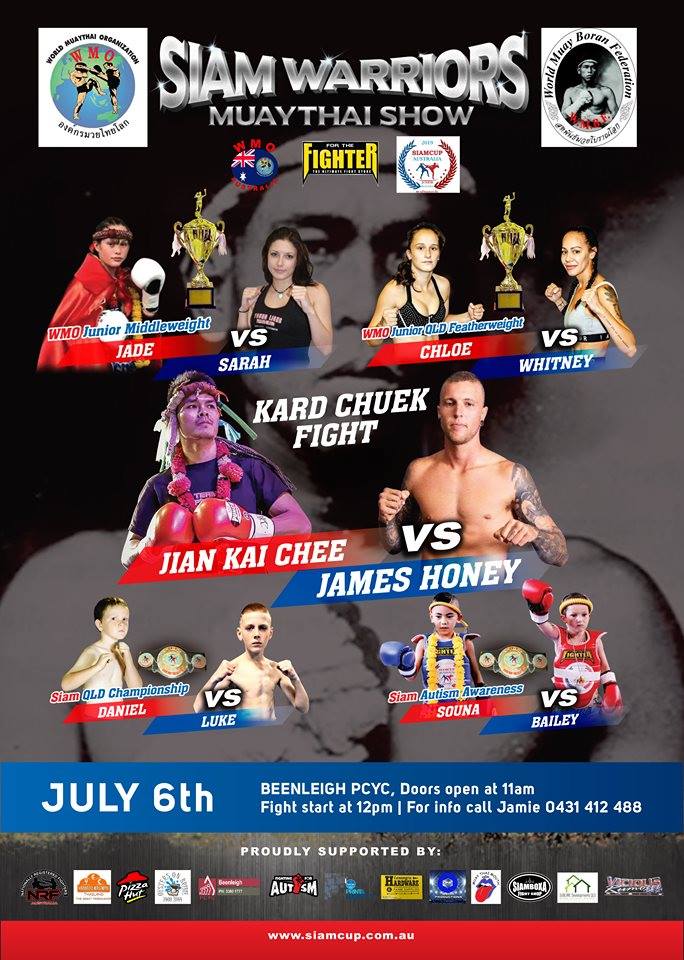Hey Team …. this is some great words on what Muay Boran and Kard Chuek is all about. Sent to me by Jamie Tozeland who is doing great things in our Muay Thai community and is bringing Kard Chuek to Australia on July 6th right here in Brisbane.
MUAYBORAN – KARD CHUEK. คาดเชือก
Some history and important information.
In ancient times, as far back as the 1700’s, tribes merged in actual clans, thats why confrontation between fighters of different region was inevitable, and each region had a different fighting style just like now days it varies from camp to camp.
According to an historic reconstruction there were five main regional styles that influenced modern Muay Thai: Korat, Lopburi , Chaiya, Thasao & Palasuksa.
We will cover the main 3.
Korat style consisted in a low guard but very stable combined with hard punches and kicks in combination of 2-3 strikes. Ropes (Chuek or Kard Chuek) were used around the hand and forearm to improve defence and to make attacks more efficient.
Lopburi was a style based on speed and precision of 4-5 strikes combos. The guard, compared to Korat style, in this style is very high and less stable (main features of the Hanuman style) which compromises the agility.
Kard Chueks covered only the hands with some padding on the knuckles (gon noi) and from here origins the modern bandage done before putting on gloves.
Chaya style featured knee, elbow, punch, and kick strikes and continuous lateral movements, step backwards and forward.
Even though only those 3 styles are considered, we can talk about another two mentioned above: These styles hail from the fusion of the three previous styles (which happened in the Rattanakosin era, during the accession of the capital that today we know at Bangkok).
Strikes could be carried out very quickly or very powerful, the guard could change based on how the fight was going. Kard Chuek would cover completely forearms and hands.
This was the time when the first arenas were being built for fighters that became than Muay Thai stadiums. Only after 1925 rules were set and after 1945 also weight categories, rounds, gloves and groin guard (at first made of bark and then changed to a shell rolled up in a cloth and then evolved to the metal one we know today), fights moved from street locations to rings in stadiums.
Arenas became real stadiums, amongst the most important we find Rajadamnern Stadium (built between 1941 and 1945 and officially opened August 23th of that year) and the one that is still today the Mecca of Muay Thai, even if not in the historic location as we explained, Lumpinee Boxing Stadium (built after the Second World War and officially opened on December 8th 1956).
Mae Mai Muay Thai took the name of Muay Thai in the period in which the Kingdom of Siam changed from an Absolute Monarchy to a Constitutional Monarchy with a Parliamentary System (July 24th 1939) that brought to the birth of the Kingdom of Thailand (“land of free men”).
During World War 2 it went back to being called Siam and then, on May 11th 1949, it permanently became Thailand.
Only after the Seventies, Muay Thai started to be known and practiced outside Thailand and in western countries. The first Europeans to discover it where the French, who at first, brought out a similar fighting style but practiced with special clothes, called Savate.
Muay boran utilizes all kinds of striking attacks as well as joint locks, throws and even ground grappling. Muay boran does not have one uniform style. Muay boran was originally developed for self defense and also taught to the Thai military for use in warfare. Matches between exponents of the art then began to be held. These soon became an integral part of Thai culture with fights being held at festivals and fighters from the different areas of Thailand testing their styles against each other. Fighters began to wrap their hands and forearms in hemp rope which not only protected their fists from injury but also made their strikes more likely to cut an opponent. Muay boran fighters were highly respected and the best were enlisted into the King’s royal guard.
The most famous Muay Boran practitioner was Nai Khanomtom. In 1774 he fought the 10 best Burmese fighters one after the other, knocking them all out. During the 1920’s-30’s King Rama VII modernized the Thai martial arts competitions, introducing referees, boxing gloves, rounds and western boxing rings. Many of the traditional Muay Boran techniques were banned or were not practical with the addition of the new rules, and so Muay Boran went into decline.
The word “Muay” translates to “boxing” so the term Muay Thai is translated as Thai Boxing. The term “Boran” translates to “ancient” and so Muay Boran is just used as an umbrella term to describe all the different variations of Thailand’s unarmed fighting before the transition to Muay Thai and the introduction of modified rules loosely based on the Marquess of Queensberry ruleset. In Muay Boran (in lieu of gloves) hemp rope is worn on the fists and matches were fought on areas of packed dirt instead of rings. The most noticeable difference though is the style of movement and stance.
The techniques in Muay Boran that look the most different from what we see today in Muay Thai are Mae Mai and Look Mai (also called “Master Tricks” and “Minor Tricks” respectively). There are 30 moves in each one. One thing to note is almost all of these techniques are still legal today, so the transition to what we’ve seen today is not a matter of an ancient style being “watered down”, but of it being simplified to techniques and strategies that work at the highest percentage. Fighters like Saenchai, Yodseanklai and Somluck still use these older tricks like the cartwheel kick and the “crocodile kick” so elements can still be found in Modern Muay Thai.
Moreover bigger promotions like “Thai Fight” & Thai Max have started promoting Kard Chuek fights (fights using hemp rope instead of gloves) to preserve elements of Muay Boran. (Kard Chuek fights always existed though and have always been very popular in smaller fight shows close to the border of Burma and Thailand despite glove fights dominating the fight scene in Bangkok after the introduction of modern Muay Thai rules.)
Modern Day Muay Kard Chuek Bound-fist boxing is still practiced in southeast Asia. In Myanmar, rope wraps are used in Lethwei or Burmese bare-knuckle boxing. In Thailand, Muay Kard Chuek is celebrated and used during matches at festivals. Keeping the tradition alive is kind of a big deal for them.
The promotion Thai Fight & Muaythai Max also do some matches in kard chuek. However, they don’t use the same wrapping methods that emphasize cutting your opponents. Instead, fighters use something like a special under glove under the ropes. There is more than 5 ways to wrap the hands in rope & You will notice that the ropes are 5 or 6mm and a bit smoother and not as unrefined as traditional Hemp ropes, sprayed with Vinegar, dipped in coconut oil & water to harden the rope to cause more damage.
Muay Boran for Juniors & Amateurs have different rules to Muay Thai, so it is scored very differently, This is why we are bringing this to Australia which gives our athletes another pathway with chances to win at WMO/WMBF World games held in Bangkok yearly.
So here in Australia we have World Muay Boran Federation, under the Banner of World Muay Thai Organisation. We have all the Thai Government certifications & approvals.
We are bringing the Culture & Heritage of age old Traditions of Muay Boran & Kard Chuek, with the Highest Respect to Thailand, Its National sport and the Thai people.
Mr Chinawut Sirisompan G.M, our KMA, WMO & WMBF Founder over looks our Developments.
The Australian President is Ravinder Sidhu in Adelaide.
The QLD President and Promoter is Jamie Tozeland.
worldmuaythai oraganisation qld-on facebook


